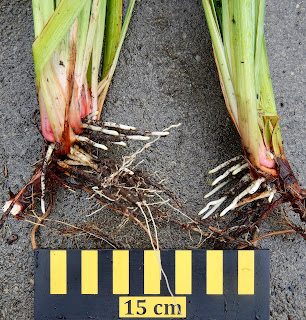Kathleen Sayce
A multi-year planting plan is coming together for fall on a dune west of my house. It began four years ago with systematic ivy removal and suppression, and continued despite the pandemic. This summer, with ivy and blackberries suppressed, remnants of an old orchard were cut down and chipped. I left 4 tall stumps about 8 feet high for future vines. The site is finally ready to plant, with a nice pile of wood chips staged to spread out.
I’ve been hoarding Pacifica iris plants for more than three years. These are a mix of unnamed vigorous seedlings, named cultivars, seedlings from same, and species seedlings—Iris tenax collections from various places in the Pacific Northwest, or color selections from Paul Rogers, who is working on named lines in a range of colors in this species. I also have a few pots of Iris innominata seedlings.
 |
| One of the stashes of PCI pots, waiting for fall |
Other plants include Pacific reedgrass (Calamagrostis nutkensis), western sword fern (Polystichum munitum), several Ceanothus species and varieties, some low growing manzanitas (Arctostaphylos), and perennial wildflowers.
The new planting area is on a sloping dune facing east, has a slope break (where the dune gets steeper) about ten to fifteen feet downslope. Ceanothus and manzanita will go in a meandering line along the slope break, with grasses and ferns above and below, and irises in between in color patches, each plant about two feet apart.
 |
| An unnamed yellow PCI with red and gold signal, ready to be planted this fall. |
Columbine, bleeding heart, yarrow, broadleaf lupine, California poppy and other wildflowers will be planted or seeded over the slope. Fringecups (Tellima grandiflora) will go in shadier areas. This native saxifrage is a great filler in planters, with lime green foliage.
As with most of my garden, this new area will get low to no irrigation. I will add compost and wood chip mulch as surface layers. By planting in fall, as the weather cools and rains begin, initial watering will be minimal, and thereafter, only in extremely dry hot events for the first 2-3 years.
 |
| Dark pink PCI with gold and very dark signal. This group has PCI 'Mission Santa Cruz' heritage. |
Gardeners often have angst-ridden thoughts about new planting areas, and I am no exception. Eik and deer spend a fair amount of time in my yard, and I worry that they will find all those new plants tasty, and eat them down, or so annoying that they pull them out. Rosemary falls into the latter category—elk regularly trample my rosemary, breaking down the branches. I prune them and reshape them; the elk trample them again. I may end up with rosemary near my house and nowhere else in the garden! A naturalist friend says elk are determined landscape engineers, and pull out or trample the plants they don’t want to make room for the ones they do.
My goal is a colorful, low to no water slope of mostly native plants, with shrubs for the Spotted Towhees, and enough ground cover for white and gold crown sparrows and other ground nesting birds. We’ll see what the deer and elk think of this!













